Brief Overview of Brush Cutters
Brush cutters are powerful gardening tools used to trim weeds, small trees, and other foliage not easily accessible by a lawn mower or rotary mower. They are designed to take on the toughest of outdoor tasks, often being used in a professional landscape, forestry, or agricultural context. Brush cutters are equipped with a cutting blade on the end of a long shaft that is powered by a motor.
The motor can be either gas or electric, and the cutting blade can be replaced with a variety of other cutting tools to suit different tasks. Brush cutters are known for their versatility, power, and ability to handle dense vegetation and undergrowth that other garden tools can’t.
While they may seem similar to string trimmers, brush cutters are designed to handle much denser material than trimmers. This makes them a valuable tool for anyone with a large outdoor area to maintain, or for those who need to clear land for other purposes.
Importance of Choosing the Right Brush Cutter
Choosing the right brush cutter is crucial for efficient and effective operation. The right tool can make the difference between a clean, well-maintained outdoor space and a messy, overgrown one. It can also impact how much time and effort you need to put into your outdoor maintenance tasks.
There are many factors to consider when choosing a brush cutter, including the type of vegetation you will be cutting, the size of the area you need to maintain, and your physical ability to handle the tool. The right brush cutter should not only be able to handle your specific needs but should also be comfortable and easy for you to use.
Furthermore, choosing a high-quality, durable brush cutter can save you money in the long run. While these tools can be more expensive upfront, they are often more cost-effective over time as they require fewer repairs and replacements.
Our Top Brush Cutter Picks
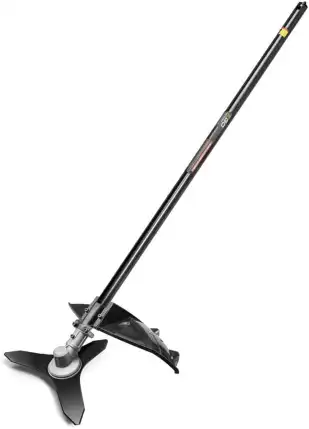
EGO Power+ BCA1220 12” Brush Cutter Attachment 56-Volt Lithium-ion Multi Head System, Black
Check on AmazonKey Specs:
- Cutting Width: 12 inches
- Blade: 3-tooth steel
- Compatibility: EGO POWER+ Multi-Head System PH1420
- Maximum Speed: 6000 RPM
- Shaft Material: Carbon fiber, lifetime warranty
The EGO Power+ BCA1220 Brush Cutter Attachment is a powerhouse for tackling tough outdoor tasks. The 12-inch, 3-tooth steel blade effortlessly clears thick brush, stalky vegetation, and saplings up to 1-inch in diameter. Its carbon fiber shaft provides durability while keeping the attachment lightweight. I appreciate the weather-resistant design, making it reliable for all seasons. This attachment is an essential companion for the EGO Multi-Head System, offering maximum performance with an impressive 6000 RPM.
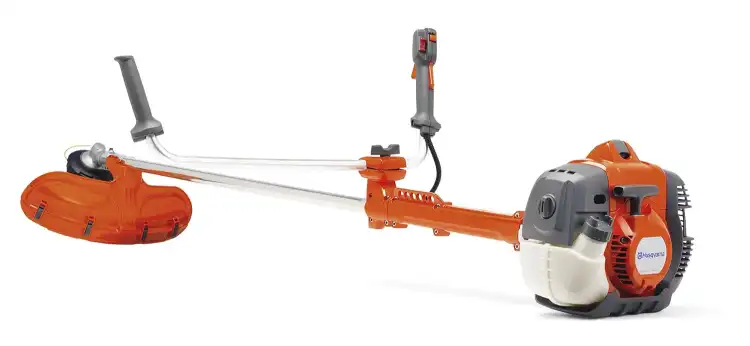
Husqvarna 336FR 966604702 Bike Handle Pro Brushcutter with Line/Brush and Saw Blade, 34.6 cc
Check on AmazonKey Specs:
- Engine Power: 34.6 cc
- Cutting Width: 18.5 inches
- Speed: 6000 RPM
- Weight: 11.2 pounds
- Handle Type: Bike handle
The Husqvarna 336FR Bike Handle Pro Brushcutter is a robust tool that delivers professional-grade performance with its 34.6 cc engine. The power behind this brushcutter makes it perfect for tackling heavy-duty tasks like thick brush and tall weeds, while the included line/brush and saw blade provide versatility for different cutting needs. With an impressive 6000 RPM and comfortable bike handle, it ensures precision and reduces fatigue. Its gas-powered engine offers reliable power for demanding outdoor jobs.
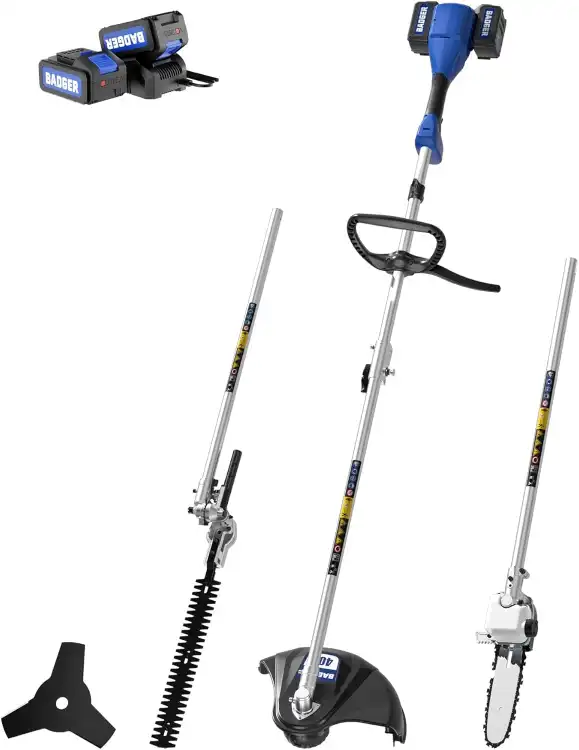
40V Cordless Weed Wacker, String Trimmer/Edger, Pole Saw, Hedge Trimmer and Brush Cutter Blade
Check on AmazonKey Specs:
- Power Source: 40V (2 x 20V batteries)
- Cutting Width: 15 inches (string trimmer)
- Battery Capacity: 2 x 20V 4Ah batteries
- Weight: 27 pounds
- Included Attachments: String trimmer/edger, pole saw, hedge trimmer, brush cutter
The Wild Badger Power 40V Cordless 4-in-1 Multi-Tool Kit is an incredibly versatile tool for any lawn care enthusiast. It combines a string trimmer, pole saw, hedge trimmer, and brush cutter, giving you four essential tools in one package. The dual 20V batteries provide ample power for extended work sessions, while the lightweight design reduces arm strain. The tool is easy to assemble, and its low vibration ensures comfortable use during prolonged jobs. A perfect all-in-one solution for yard maintenance.
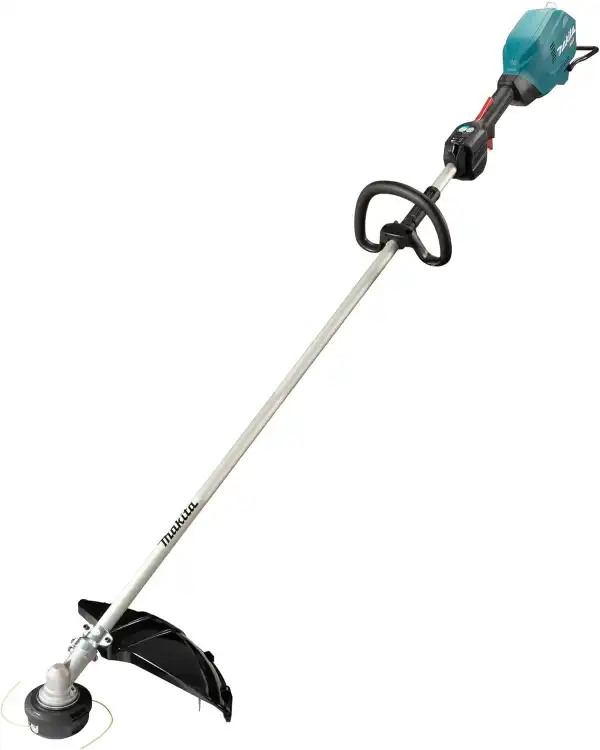
Makita Brushcutter 40Vmax XGT BL Handle D AFT ADT High Torque Brand
Check on AmazonKey Specs:
- Power Source: 40Vmax XGT battery
- Motor: Brushless motor with variable speed control
- Cutting Width: 255 mm
- Weight: 5.9 kg
- Technology: AFT for safety, electric brake for faster stops
The Makita 40Vmax XGT Brushcutter is an exceptional tool for serious landscapers and professionals. Powered by a 40Vmax XGT motor, it delivers the power of a traditional 30cc petrol engine with enhanced efficiency and less maintenance. The brushless motor ensures smoother operation with variable speeds—ranging from 4,600 to 7,000 rpm—providing precise control over different tasks. AFT technology protects the user by shutting down the tool if the rotation speed suddenly decreases, ensuring safety and performance. This brushcutter is built for tough, long-lasting use.
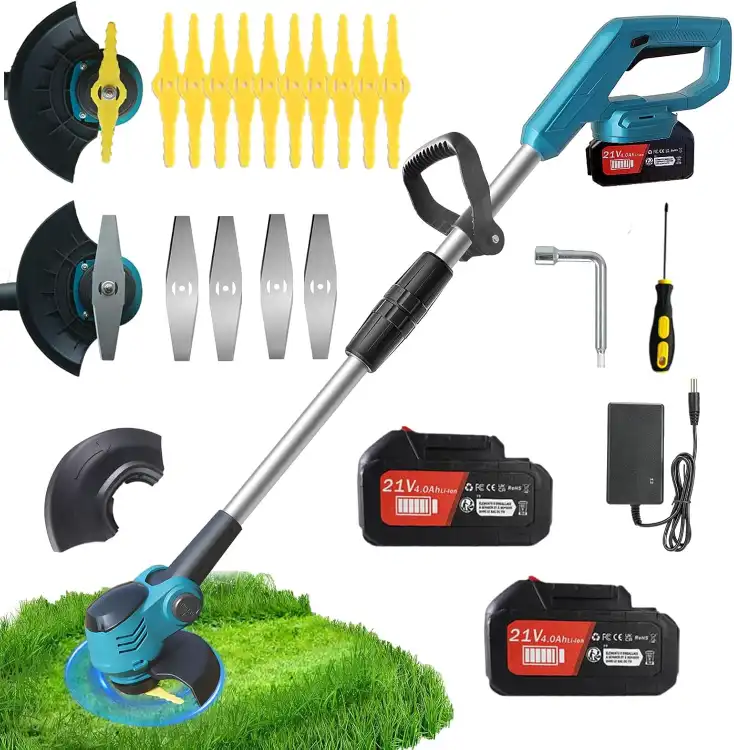
Cordless Weed Wacker 21V Electric Weed Wacker with 2 4.0Ah Batteries, 3 in 1 Grass Trimmer/Brush Cutter/Edge Equipped
Check on AmazonKey Specs:
- Power Source: 21V battery (2x 4.0Ah lithium-ion batteries)
- Motor: 850W pure copper motor
- Cutting Width: 6 inches
- Weight: 6 pounds
- Blade Options: 4 metal blades, 10 plastic blades, and safety features like anti-collision wire
The Xbzzgmg Cordless Weed Wacker is a versatile, lightweight tool designed for ease of use and extended operation. Equipped with two 4.0Ah lithium-ion batteries, it offers up to 2 hours of run time. The upgraded metal and plastic blades ensure it can handle both thick weeds and tender grass with ease. Weighing just 6 pounds, it’s perfect for anyone, including women and elderly users. The adjustable head and safety features like the double switch safety lock make it an excellent choice for precise and safe lawn care.
Understanding Brush Cutters
Definition and Purpose of Brush Cutters
Brush cutters, also known as brush saws or clearing saws, are powerful tools used to cut through dense vegetation and undergrowth. They are designed to handle tough outdoor tasks that other garden tools can’t, such as cutting through thick weeds, small trees, and heavy undergrowth.
The primary purpose of a brush cutter is to clear land. This can be for a variety of reasons, including preparing land for construction, maintaining trails, controlling weeds, or managing forests. Brush cutters are also commonly used in agriculture, for tasks such as clearing fields of overgrown vegetation.
Brush cutters are designed with a long shaft, which allows the user to reach vegetation without having to bend over or reach out. This design also allows for greater reach when cutting, making it easier to cut through dense areas of vegetation.
Different Types of Brush Cutters
There are several types of brush cutters available, each designed for specific tasks and uses. The most common types include handheld brush cutters, walk-behind brush cutters, and tow-behind brush cutters.
Handheld brush cutters are the most common type and are typically used for smaller tasks. They are lightweight and easy to maneuver, making them ideal for trimming around trees, along fences, and in other tight spaces. Handheld brush cutters are typically powered by gas or electricity.
Walk-behind brush cutters, also known as brush mowers, are larger and more powerful than handheld models. They are designed to handle larger areas and denser vegetation, making them ideal for clearing large fields or overgrown land. Walk-behind brush cutters are typically gas-powered.
Tow-behind brush cutters are designed to be attached to a tractor or other vehicle. They are the most powerful type of brush cutter and are used for the largest and most challenging land-clearing tasks. Tow-behind brush cutters are ideal for large properties, commercial landscaping, and forestry work.
Factors to Consider When Buying a Brush Cutter
Power Source: Gas vs. Electric
One of the first decisions you’ll need to make when choosing a brush cutter is whether to go with a gas-powered or electric model. Both types have their advantages and disadvantages, and the best choice depends on your specific needs and preferences.
Gas-powered brush cutters are generally more powerful than electric models, making them a good choice for heavy-duty tasks and dense vegetation. They are also more mobile, as they don’t require a power cord. However, gas models are also heavier, noisier, and require more maintenance than electric models.
Electric brush cutters, on the other hand, are lighter, quieter, and easier to maintain than gas models. They are also more environmentally friendly, as they don’t produce emissions. However, they are less powerful than gas models and require a power source, which can limit mobility.
Cutting Width
The cutting width of a brush cutter refers to the diameter of the area that the tool can cut in a single pass. This is determined by the size of the cutting blade or string. The larger the cutting width, the more area the brush cutter can cover in a single pass, which can make your work more efficient.
However, a larger cutting width also means a larger, heavier tool, which may not be suitable for all users. If you’re working in a tight space or need to maneuver around obstacles, a smaller cutting width may be more beneficial. It’s important to choose a cutting width that is suitable for your specific needs and abilities.
Most brush cutters have a cutting width between 10 and 24 inches. Handheld models typically have a smaller cutting width, while walk-behind and tow-behind models have a larger cutting width.
Weight and Comfort
The weight of a brush cutter can significantly impact its ease of use and your comfort while operating it. A heavy brush cutter can be difficult to maneuver and can cause fatigue over time, especially if you’re using it for extended periods. On the other hand, a lightweight model may not have the power or durability to handle heavy-duty tasks.
When considering the weight of a brush cutter, it’s also important to consider the tool’s balance. A well-balanced tool will be easier to control and can reduce fatigue. Look for a brush cutter with a comfortable handle and a design that distributes weight evenly.
Comfort features such as padded handles and shoulder straps can also make a big difference in your comfort and ease of use. These features can help reduce fatigue and prevent discomfort during long periods of use.
Durability and Reliability
When investing in a brush cutter, you want a tool that will last. The durability of a brush cutter is largely determined by its build quality and the materials used in its construction. Look for a brush cutter with a sturdy, robust construction and high-quality materials.
Reliability is another important factor to consider. A reliable brush cutter will perform consistently and require fewer repairs and replacements. Look for a model from a reputable manufacturer with good customer reviews.
Finally, consider the warranty and after-sales service offered by the manufacturer. A good warranty can provide peace of mind and protect your investment, while good after-sales service can ensure that you get the support you need if you encounter any issues with your brush cutter.
Detailed Analysis of Brush Cutter Types
Handheld Brush Cutters
Handheld brush cutters are the most common type of brush cutter and are ideal for smaller tasks and lighter vegetation. They are lightweight and easy to maneuver, making them perfect for trimming around trees, along fences, and in other tight spaces.
Handheld brush cutters are typically powered by either gas or electricity. Gas models are more powerful and can handle denser vegetation, but they are also heavier, noisier, and require more maintenance. Electric models are lighter, quieter, and easier to maintain, but they require a power source and may not be as powerful as gas models.
When choosing a handheld brush cutter, consider the type of vegetation you’ll be cutting, the size of the area you’ll be working in, and your physical ability to handle the tool. Look for a model with a comfortable handle, a well-balanced design, and a suitable cutting width for your needs.
Walk-Behind Brush Cutters
Walk-behind brush cutters, also known as brush mowers, are larger and more powerful than handheld models. They are designed to handle larger areas and denser vegetation, making them ideal for clearing large fields or overgrown land.
Walk-behind brush cutters are typically gas-powered, which provides the power needed to handle tough tasks. They feature large cutting widths, which allows them to cover a large area in a single pass. However, their size and power also make them heavier and more difficult to maneuver than handheld models.
When choosing a walk-behind brush cutter, consider the size of the area you’ll be working in and the type of vegetation you’ll be cutting. Look for a model with a comfortable handle, a sturdy construction, and a suitable cutting width for your needs.
Tow-Behind Brush Cutters
Tow-behind brush cutters are the most powerful type of brush cutter and are designed for the largest and most challenging tasks. They are ideal for large properties, commercial landscaping, and forestry work.
Tow-behind brush cutters are designed to be attached to a tractor or other vehicle, which provides the power needed to handle heavy-duty tasks. They feature large cutting widths, which allows them to cover a large area in a single pass. However, their size and power also make them the heaviest and most difficult to maneuver type of brush cutter.
When choosing a tow-behind brush cutter, consider the size of the area you’ll be working in, the type of vegetation you’ll be cutting, and the power of your tractor or vehicle. Look for a model with a sturdy construction, a suitable cutting width for your needs, and a reliable hitch for attaching to your vehicle.
Understanding the Power Source Options
Pros and Cons of Gas-Powered Brush Cutters
Gas-powered brush cutters are the most common type of brush cutter and are known for their power and mobility. They are capable of handling heavy-duty tasks and dense vegetation, making them a popular choice for professional landscapers and those with large properties.
One of the main advantages of gas-powered brush cutters is their power. They are generally more powerful than electric models, which allows them to cut through dense vegetation and handle tough tasks with ease. They are also more mobile, as they don’t require a power cord.
However, gas-powered brush cutters also have their disadvantages. They are heavier, noisier, and require more maintenance than electric models. They also produce emissions, which can be harmful to the environment.
Pros and Cons of Electric-Powered Brush Cutters
Electric-powered brush cutters are a more modern alternative to traditional gas-powered models. They are lighter, quieter, and easier to maintain, making them a popular choice for homeowners and those with smaller properties.
One of the main advantages of electric-powered brush cutters is their ease of use. They are lighter and easier to maneuver than gas models, and they require less maintenance. They are also quieter, which can be a significant advantage in residential areas.
However, electric-powered brush cutters also have their disadvantages. They are less powerful than gas models, which may limit their effectiveness on dense vegetation and heavy-duty tasks. They also require a power source, which can limit their mobility.
Importance of Cutting Width in Brush Cutters
How Cutting Width Affects Performance
The cutting width of a brush cutter refers to the diameter of the area that the tool can cut in a single pass. This is determined by the size of the cutting blade or string. The larger the cutting width, the more area the brush cutter can cover in a single pass, which can make your work more efficient.
However, a larger cutting width also means a larger, heavier tool, which may not be suitable for all users. If you’re working in a tight space or need to maneuver around obstacles, a smaller cutting width may be more beneficial. It’s important to choose a cutting width that is suitable for your specific needs and abilities.
Most brush cutters have a cutting width between 10 and 24 inches. Handheld models typically have a smaller cutting width, while walk-behind and tow-behind models have a larger cutting width.
Choosing the Right Cutting Width for Your Needs
When choosing a brush cutter, it’s important to consider the size of the area you’ll be working in and the type of vegetation you’ll be cutting. If you’re working in a large area with dense vegetation, a brush cutter with a larger cutting width may be more efficient. However, if you’re working in a smaller area or need to maneuver around obstacles, a brush cutter with a smaller cutting width may be more suitable.
It’s also important to consider your physical ability to handle the tool. A brush cutter with a larger cutting width will be heavier and more difficult to maneuver, which may not be suitable for all users. On the other hand, a brush cutter with a smaller cutting width will be lighter and easier to handle, but it may not be as efficient for large tasks.
When choosing a cutting width, consider your specific needs and abilities, and try out different models to see what feels most comfortable and efficient for you.
Weight and Comfort: Key to Efficient Use
Impact of Weight on User Comfort and Efficiency
The weight of a brush cutter can significantly impact its ease of use and your comfort while operating it. A heavy brush cutter can be difficult to maneuver and can cause fatigue over time, especially if you’re using it for extended periods. On the other hand, a lightweight model may not have the power or durability to handle heavy-duty tasks.
When considering the weight of a brush cutter, it’s also important to consider the tool’s balance. A well-balanced tool will be easier to control and can reduce fatigue. Look for a brush cutter with a comfortable handle and a design that distributes weight evenly.
Comfort features such as padded handles and shoulder straps can also make a big difference in your comfort and ease of use. These features can help reduce fatigue and prevent discomfort during long periods of use.
Features to Look for Maximum Comfort
When choosing a brush cutter, look for features that will enhance your comfort and ease of use. These may include a comfortable handle, a well-balanced design, and a suitable weight for your physical ability.
A comfortable handle can make a big difference in your comfort and control while using the brush cutter. Look for a handle with a comfortable grip and an ergonomic design. Some models also feature adjustable handles, which can be adjusted to suit your height and reach.
A well-balanced design can also enhance your comfort and control. Look for a brush cutter that distributes weight evenly, which can make the tool easier to maneuver and reduce fatigue.
Finally, consider the weight of the brush cutter. A lightweight model will be easier to handle and can reduce fatigue, but it may not have the power or durability to handle heavy-duty tasks. On the other hand, a heavy model may be more powerful and durable, but it can be difficult to maneuver and can cause fatigue over time.
Durability and Reliability: Getting Value for Money
Importance of Material and Build Quality
When investing in a brush cutter, you want a tool that will last. The durability of a brush cutter is largely determined by its build quality and the materials used in its construction. Look for a brush cutter with a sturdy, robust construction and high-quality materials.
High-quality materials can enhance the durability and longevity of the brush cutter. Look for a model with a strong, durable cutting blade and a robust motor. The handle and other components should also be made from durable materials that can withstand regular use.
The build quality of the brush cutter is also important. A well-built brush cutter will be more durable and reliable, and it will perform better over time. Look for a model with a sturdy construction, good balance, and smooth operation.
Warranty and After-Sales Service Considerations
When investing in a brush cutter, it’s also important to consider the warranty and after-sales service offered by the manufacturer. A good warranty can provide peace of mind and protect your investment, while good after-sales service can ensure that you get the support you need if you encounter any issues with your brush cutter.
Look for a manufacturer that offers a comprehensive warranty that covers both the motor and other components of the brush cutter. The warranty should cover any defects in materials or workmanship, and it should provide for repair or replacement of defective parts.
Good after-sales service is also important. Look for a manufacturer that offers good customer support, including easy access to replacement parts and service centers. Good after-sales service can ensure that you get the most out of your brush cutter and that you can keep it in good working order for years to come.
Safety Features to Look for in Brush Cutters
Essential Safety Features
Brush cutters are powerful tools, and it’s important to use them safely. When choosing a brush cutter, look for features that enhance safety and prevent accidents.
One essential safety feature is a blade guard. This is a shield that covers the cutting blade to prevent accidental contact. The blade guard should be sturdy and well-designed to provide effective protection.
Another important safety feature is a safety switch or lock-off button. This is a feature that prevents the brush cutter from being started accidentally. The safety switch should be easy to access and operate.
Some brush cutters also feature a harness or shoulder strap, which can enhance safety and control. The harness should be comfortable and adjustable, and it should distribute weight evenly to reduce fatigue and enhance control.
Additional Safety Gear for Users
In addition to the safety features on the brush cutter itself, it’s also important to use appropriate safety gear when operating the tool. This can include safety glasses, gloves, sturdy footwear, and hearing protection.
Safety glasses can protect your eyes from flying debris, while gloves can protect your hands from cuts and abrasions. Sturdy footwear can protect your feet from injury and provide stability and traction while working.
Hearing protection is also important, especially when using gas-powered brush cutters, which can be quite noisy. Look for earplugs or earmuffs that are comfortable and provide adequate noise reduction.
Maintenance Tips for Brush Cutters
Routine Maintenance Practices
Regular maintenance is essential to keep your brush cutter in good working order and to extend its lifespan. This can include cleaning the tool after each use, checking and replacing the cutting blade as needed, and performing regular checks on the motor and other components.
After each use, clean the brush cutter to remove any dirt, grass, or other debris. This can help prevent rust and other damage. Check the cutting blade for wear and replace it as needed. Dull blades can reduce the efficiency of the brush cutter and can cause strain on the motor.
Regularly check the motor and other components for signs of wear or damage. If you notice any issues, have the brush cutter serviced by a professional. Regular maintenance can help prevent major issues and can keep your brush cutter running smoothly for years to come.
Troubleshooting Common Issues
Even with regular maintenance, you may encounter issues with your brush cutter from time to time. Common issues can include difficulty starting the tool, reduced cutting power, and excessive vibration.
If you’re having difficulty starting the brush cutter, check the fuel or power source. If you’re using a gas model, make sure the fuel is fresh and the fuel lines are clear. If you’re using an electric model, make sure the power cord is securely connected and the outlet is working.
If you notice reduced cutting power, check the cutting blade. A dull or damaged blade can reduce the efficiency of the brush cutter. Replace the blade if necessary.
Excessive vibration can be a sign of an unbalanced blade or other issue. Check the blade for damage
